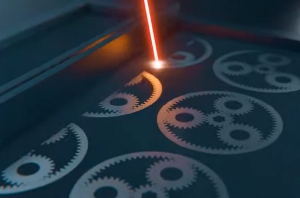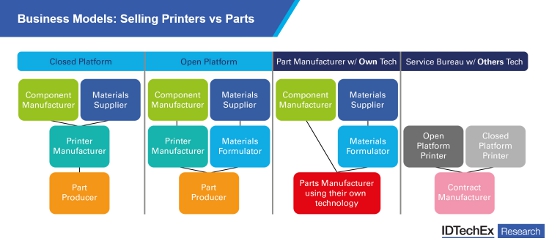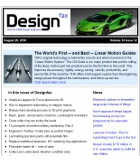 |
| July 12, 2022 | Volume 18 Issue 26 |
Designfax weekly eMagazine
Archives
Partners
Manufacturing Center
Product Spotlight
Modern Applications News
Metalworking Ideas For
Today's Job Shops
Tooling and Production
Strategies for large
metalworking plants
Metal 3D Printing: Alternative market players
By Sona Dadhania, Technology Analyst, IDTechEx

Sona Dadhania.
Decades of an industry following the same business strategy has exposed the inherent difficulties in selling printers, especially metal printers, to end-users. First, customers will need to find the budget for a printer costing hundreds of thousands of dollars, alongside consumable printing materials that cost hundreds per kilogram. Then, the customers will need to train employees to operate these printers and how to prepare and finish any 3D-printed parts; if the customer doesn't have the internal resources for this, they will need to hire skilled labor. Lastly, to make the most of any 3D printer, customers need to understand how to identify applications where 3D printing offers the most value-add and how to design for these opportunities.

Seurat Technologies is a startup making waves in the metal AM industry. The company's Area Printing innovates on laser powder bed fusion, a process often plagued with speed issues, to improve on build volume and part throughput. [Image credit: Seurat Technologies]
Overall, these factors make convincing customers to invest in 3D printing, especially metal additive manufacturing, a difficult decision to make. That is not to say the metal printer install base is not growing, but that this increasingly popular business model fits into a growing industry that IDTechEx forecasts will reach $18.5 billion by 2032, according to their latest report, "Metal Additive Manufacturing 2022-2032: Technology and Market Outlook."
A new strategy: In-house production
New entrants have recognized the obstacles posed by the traditional business model of selling metal printers to customers for them to print parts. Rather than selling the printers using their proprietary technology like traditional 3D-printer manufacturers, they have chosen a different business strategy where they keep their proprietary printing technology in-house.
Here, the 3D printer is not the main product being sold; rather, finished 3D-printed parts are the main product. This circumvents many of the classic barriers to 3D-printing adoption, like high capital expenses and the need for specialized AM knowledge. Rather than having to convince customers that the customer can print great components if they buy a 3D printer, in-house production companies can simply demonstrate that their proprietary printers can indeed manufacture complex, custom parts.

An infographic of select business models utilized in the 3D-printing industry, including Metal Additive Manufacturing. [Source: IDTechEx - "Metal Additive Manufacturing 2022-2032: Technology and Market Outlook"]
In this way, in-house production companies using their own proprietary technology are like vertically integrated OEMs. Not only will these companies develop their own printing technology and equipment, but they also often develop their own materials for their proprietary printers. As parts manufacturers delivering finished components to customers, they also complete any post-processing that is needed (i.e., depowdering, debinding, sintering, milling, finishing, etc.). Some also use their own in-house software for design and simulation. Vertical integration makes it possible to provide a full suite of services to end-users: part manufacturing, consulting, design, etc.
3D production players to keep an eye on
In the metal additive manufacturing industry, most are familiar with the classic 3D-printer manufacturers selling their printers for part production, like EOS, SLM Solutions, ExOne, and more. Many of these do have in-house part production, but this is not the main focus and typically runs at a small scale. New entrants with a proprietary process exclusively for in-house production are appearing on the metal AM landscape. Who are some of the players to look for?
- 3DEO is the American startup behind Selective Inhibition Sintering, a novel metal binder jetting process that is similar in principle to Multi-Jet Fusion and High Speed Sintering. Here, an anti-fusing agent is applied alongside the binder to create high-quality, consolidated metal parts. 3DEO kept Selective Inhibition Sintering in-house to focus on high-volume production services, which is difficult for customers purchasing 3D printers to accomplish. In 2021, 3DEO announced they had printed their millionth part.
- Having raised $79 million as of Q1 2022 to commercialize their proprietary Area Printing technology, Seurat Technologies is another American startup making waves in the metal AM industry. Area Printing innovates on laser powder bed fusion, a process often plagued with speed issues, to improve on build volume and part throughput. Seurat is currently running a customer adoption program to help customers identify key applications for their technology.
- The oldest company on this list, Norsk Titanium uses its Rapid Plasma Deposition technology not only exclusively for in-house production but exclusively for in-house titanium part production for industrial applications. Though Norsk has the narrowest business focus of the companies listed, this specificity allows them to concentrate on high-value verticals with qualification and validation needs like aerospace. In fact, one of Norsk's notable customers is Boeing.
- Relativity Space is an American aerospace company with over 700 employees and $1.34 billion in funding that has created their own metal additive manufacturing technology for rocket manufacturing. Called Stargate, it is the world's largest metal 3D printer, according to Relativity, capable of printing a single metal piece up to 32 ft tall. Stargate is utilized by Relativity to manufacture parts for their own rockets.
- A spin-out of Autodesk, Holo has developed a technology platform called PureForm™. PureForm uses a proprietary vat photopolymerization printer designed for high-volume production to cure photopolymer resin loaded with metal powder and create a green part. That part is debound and sintered to remove the photopolymer and densify the final metal part. This technology is notable for being well suited for pure copper 3D printing, which is tricky to accomplish with powder bed fusion.
VIDEO: 3DEO: How it Works -- Intelligent Layering.
VIDEO: Seurat Technologies: Area Printing explained.
VIDEO: Norsk Titanium: Rapid Plasma Deposition.
VIDEO: Relativity Space: Stargate printer in action (timelapse of interstage tank for Terran 1 rocket).
VIDEO: Holo: Creating high-performance Solutions -- PureForm long presentation.
Metal AM is not the only 3D-printing specialty seeing this strategy being implemented, considering the emergence of companies like Arevo and Arris Composites in composite 3D printing and OPT Industries and Spectroplast in polymer 3D printing. With startups now considering alternate business strategies from their founding, IDTechEx expects to see more AM companies pursuing this interesting approach to increasing 3D-printing adoption.
It should be noted that this type of business will not displace traditional service bureaus. Service bureaus have the benefit of being technology-agnostic with the ability to collate printers from different processes and companies in a single company. With service bureaus like Materialise and Protolabs generating hundreds of millions of dollars in revenue each year, the contract manufacturing sector of the 3D-printing industry will continue to grow strongly.
Market forecasts for metal additive manufacturing
IDTechEx's report on metal additive manufacturing forecasts future revenue, install base, and materials demand for the metal AM market, while carefully segmenting the metal AM technology and materials market by 10 process categories and nine metal material categories. Additionally, IDTechEx analyzes each metal printing technology and provides detailed discussion on the metal AM materials market. For further information on this market, including interview-based profiles of the main players, technology benchmarking studies, granular 10-year market forecasts, and application case studies, see the IDTechEx market report, "Metal Additive Manufacturing 2022-2032: Technology and Market Outlook."
Published July 2022
Rate this article
View our terms of use and privacy policy
